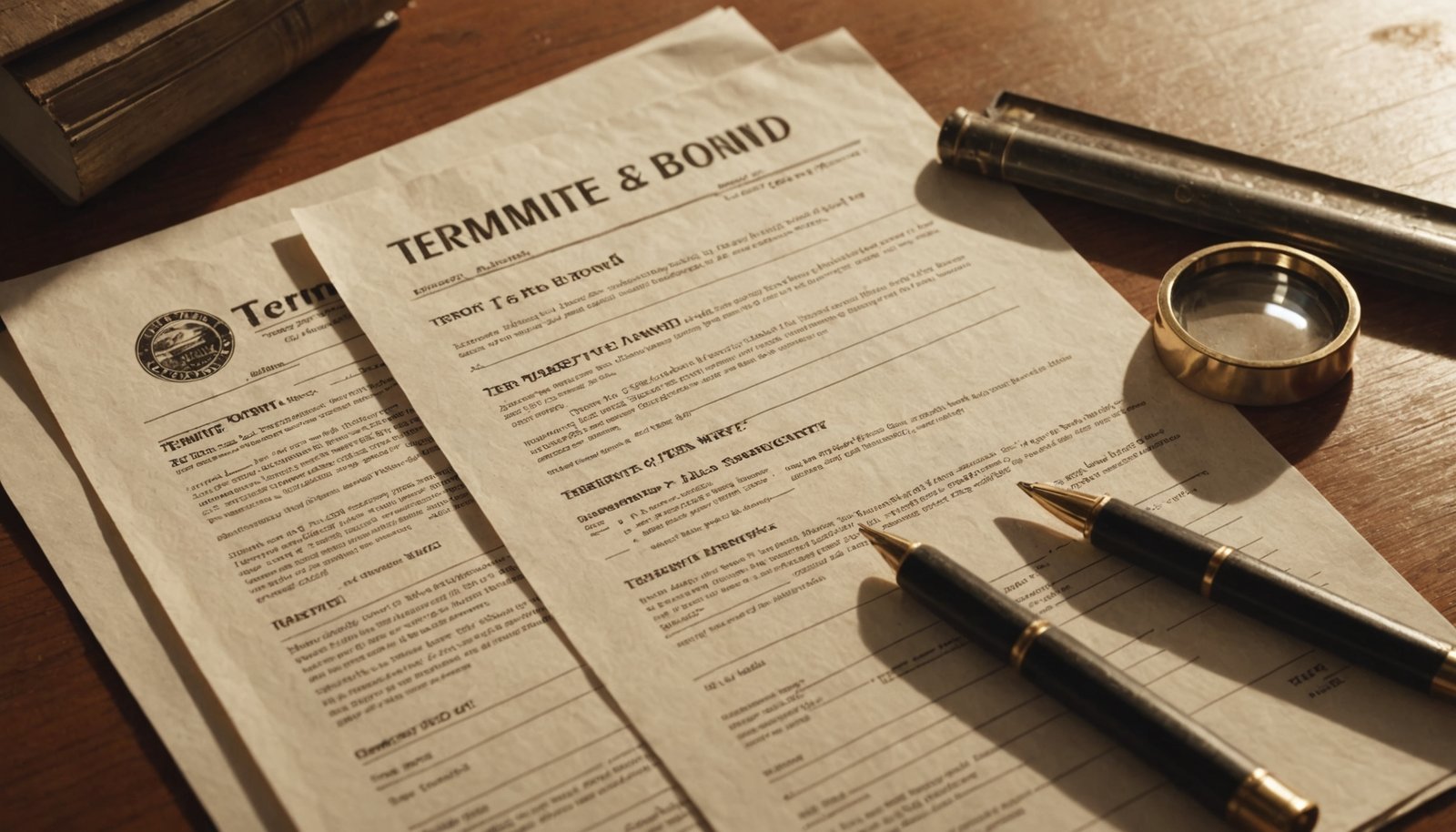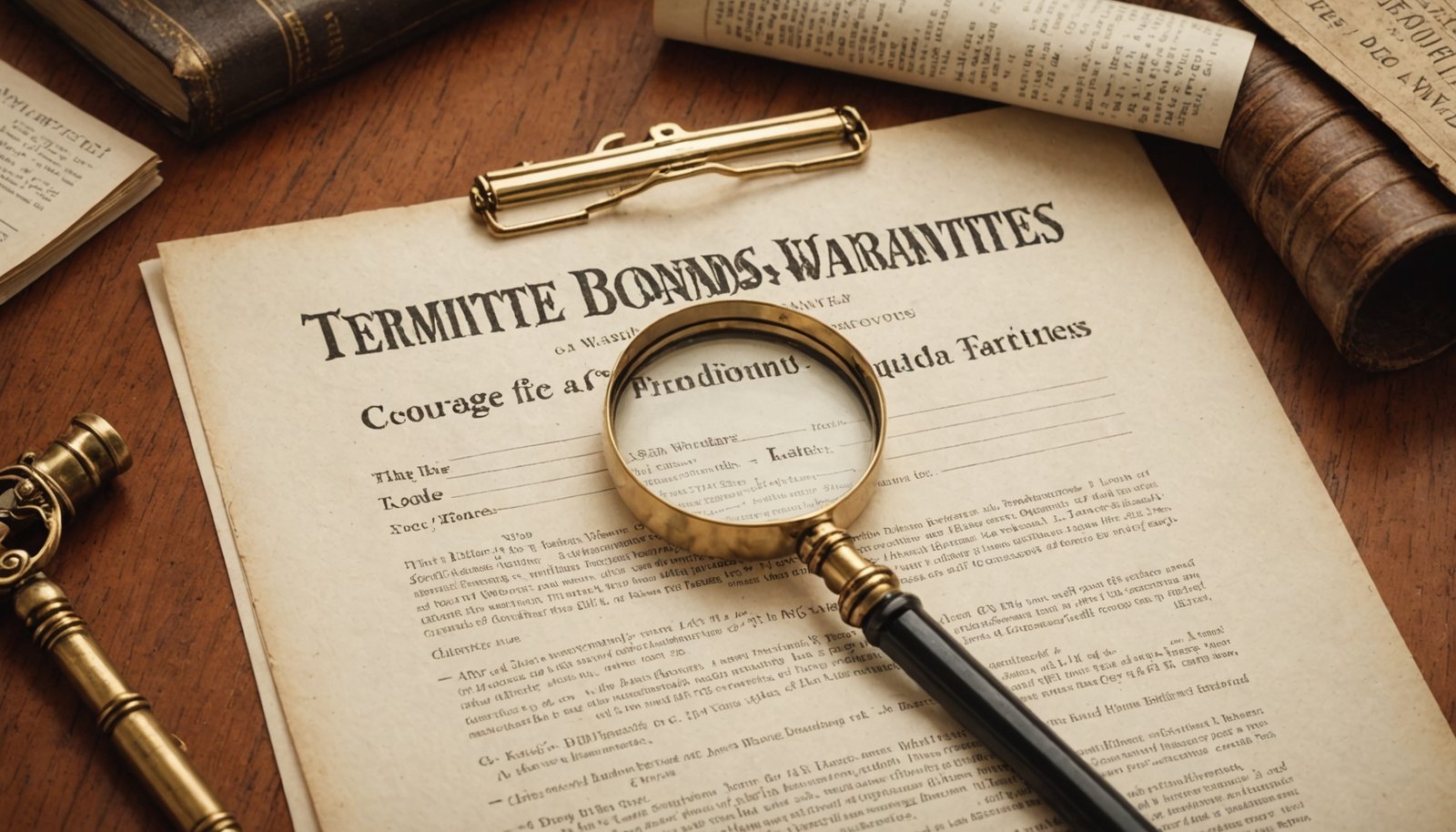Termite Bonds and Warranties: What Homeowners Should Know
You’ll need specialized protection against termite damage since standard homeowner’s insurance won’t cover it. Termite bonds provide annual inspections and guaranteed retreatment, while warranties offer broader coverage including structural repairs. Both require yearly renewal and inspections to maintain validity, with costs ranging from $300-$1,000 annually. Given that untreated infestations can cause up to $100,000 in damage, understanding your coverage options can save you from significant financial risks.
Key Takeaways
- Termite bonds provide annual inspections and retreatment coverage, while warranties offer additional protection for structural damage repairs up to specific limits.
- Regular inspections are mandatory to maintain coverage validity, with most plans requiring yearly renewal to prevent coverage gaps.
- Homeowners insurance typically excludes termite damage, making bonds or warranties essential protection against costly repairs ranging from $3,000-$100,000.
- Termite bonds are often transferable during home sales, adding property value and increasing buyer confidence in real estate transactions.
- Choose licensed pest control providers by comparing coverage options, reviewing customer feedback, and evaluating inspection thoroughness.
Understanding the Difference Between Termite Bonds and Warranties

Protection against termite damage comes in two main forms: termite bonds and warranties. When you’re choosing between them, it’s essential to understand their distinct features.
A termite bond is a service contract with your pest control provider that includes annual inspections and retreatment if termites return. You’ll need to renew it yearly to maintain coverage.
Annual inspections and guaranteed retreatment are included in a termite bond, making it a valuable service contract for ongoing pest protection.
A termite warranty, on the other hand, functions more like insurance, offering extensive coverage that often includes both treatment and repair coverage for termite damage. While homeowners insurance typically won’t cover termite-related issues, warranties can protect you up to specific financial limits.
Each option has unique renewal requirements, so you’ll want to carefully review the terms. Bonds focus primarily on retreatment, while warranties generally provide broader protection against both infestation and damage.
Key Coverage Types and Protection Levels

You’ll find two main coverage options when choosing termite protection: repair plans that cover structural damage and retreatment plans that only cover additional treatments when termites return.
Your coverage limits will depend on the specific plan you select, with extensive warranties typically offering higher protection amounts for both treatment and repairs.
When transferring or renewing your bond, you’ll need to stay current with required inspections and understand the exclusions that might affect your coverage, such as pre-existing damage or hard-to-reach areas.
Repair vs. Retreatment Plans
When choosing a termite warranty, you’ll need to decide between two main coverage types: retreatment-only plans and broad repair coverage.
While retreatment warranties only cover additional pest control treatments if termites return, extensive warranties protect you against both retreatment costs and structural repairs.
You should know that most homeowners insurance doesn’t cover termite damage, making your choice of warranty critical.
Extensive coverage typically includes specific limits on repair costs, which vary by provider. Regular inspections are usually required to maintain your warranty’s validity, regardless of the plan you choose.
Consider that termite damage can cost anywhere from $3,000 to over $100,000, so selecting adequate coverage is essential.
Basic warranties may have exclusions, so carefully review what’s covered before committing to a plan.
Coverage Limits and Exclusions
Coverage limits and exclusions can greatly impact your termite warranty’s effectiveness. While extensive termite warranties and bonds may offer up to $250,000 in repair coverage, it’s essential to understand what’s not protected.
Most plans won’t cover damage that existed before the initial treatment or above-ground infestations that develop later.
You’ll need to maintain regular inspections to keep your coverage valid. If you skip these check-ups or make structural changes that prevent proper inspection, you could void your warranty.
Remember that standard homeowners insurance policies typically don’t protect against termite damage, making your warranty or bond your primary financial protection.
When choosing coverage, carefully consider whether you need a basic retreat-only plan or a thorough warranty that includes both treatment and repairs.
Bond Transfer and Renewal
Understanding your termite bond’s transfer and renewal options can greatly impact your home’s long-term protection. Most termite bonds require annual renewal with a 12-month initial term, and letting your coverage lapse can lead to higher costs later.
When you’re considering bond transfer, you’ll find that termite bonds often add value during home sales since they’re typically transferable between homeowners, unlike some warranties.
Your renewal process will include mandatory inspections of visible and accessible areas. You’ll need to maintain clear access for inspectors and follow contract terms carefully.
Be aware that coverage types vary between retreat-only and retreat-and-repair bonds, with specific exclusions for above-ground infestations and inaccessible areas. To maintain your protection, you’ll need to stay current with inspections and understand your bond’s particular requirements.
Essential Terms and Conditions to Review

Before signing any termite bond or warranty agreement, you’ll need to carefully examine several critical terms and conditions that could greatly impact your protection.
Understanding these details will help you avoid unexpected costs and guarantee extensive coverage for your home.
- Review coverage limits carefully, as they determine the maximum amount you’ll receive for termite-related repairs and damages.
- Check exclusions in your agreement, particularly regarding pre-existing damage, natural disasters, and areas that may be difficult to inspect.
- Confirm renewal requirements, including mandatory annual inspections that maintain your coverage’s validity.
- Understand all potential out-of-pocket costs, including deductibles and service fees, and verify if your warranty’s transferability adds value when selling your home.
The Real Costs of Termite Damage and Prevention
Your financial exposure to termite damage extends far beyond the annual treatment costs of $300-$1,000, as untreated infestations can silently cause devastating structural damage reaching six figures.
You’ll need to take into account both the upfront prevention expenses and potential repair costs, especially since standard homeowners’ insurance won’t cover termite-related damages.
Without a thorough termite bond or warranty in place, you’re personally responsible for all treatment and repair costs that could greatly impact your property’s value and your financial stability.
Annual Treatment Investment Breakdown
The stark reality of termite damage presents homeowners with a critical financial decision: invest in prevention or risk costly repairs.
While homeowners insurance won’t cover termite-related issues, investing in prevention through a termite bond or warranty can protect your home from devastating expenses.
Here’s what you’ll typically invest annually for thorough termite protection:
- Annual termite bond cost: $500-$2,500 (averaging $1,500)
- Regular inspection fees: Included in most termite warranty plans
- Preventive treatment applications: Part of your annual protection package
- Documentation and monitoring: Essential for maintaining coverage validity
Hidden Property Damage Expenses
While annual termite protection costs may seem substantial, they pale in comparison to the staggering expenses of undetected termite damage.
You’re looking at repair costs ranging from $3,000 to over $100,000 for severe infestations, and your homeowners insurance won’t cover it.
That’s why termite bonds and warranties are essential for protecting your financial future.
Detailed coverage includes both retreatment and repair costs, greatly reducing your financial risk.
Regular inspections, which come with most termite control warranties, help catch hidden property damage before it becomes extensive.
For an average investment of $500 to $2,500, you’ll get peace of mind knowing you’re protected against the $5 billion in annual property damage that termites cause nationwide.
Insurance Coverage Gap Realities
Most homeowners don’t realize they’re walking a financial tightrope when it comes to termite damage, since standard insurance policies won’t cover these destructive pests.
This coverage gap leaves you vulnerable to repair costs that can soar well beyond $100,000, making termite bonds and extensive warranties vital for financial protection.
- Your homeowners insurance explicitly excludes termite damage, creating a significant risk for out-of-pocket expenses.
- Extensive warranties from a pest control company can cover both treatment and repairs.
- Annual inspections bundled with termite bonds help detect problems early, preventing catastrophic damage.
- Without proper coverage, you’ll face the full burden of repair costs, which average $3,000 to $100,000 depending on infestation severity.
These realities make protective measures essential for safeguarding your property investment.
Maintaining Your Termite Protection Plan
Successfully maintaining your termite protection plan requires diligent record-keeping and proactive management.
Effective termite protection demands careful documentation and an active approach to safeguarding your property investment.
You’ll need to keep all treatment records, warranty certificates, and inspection reports organized and easily accessible to maintain coverage effectively. Don’t forget to mark renewal dates and set reminders for timely payments to avoid costly coverage gaps.
Your termite warranty serves as a crucial shield against property damage, but you must fulfill your responsibilities.
Schedule and facilitate annual inspections by providing complete access to your home’s inspection points. If you spot any signs of termite activity, report them immediately to your pest control provider and document the situation.
Remember to follow all termite prevention recommendations, including moisture control and proper ventilation, to maximize your protection plan’s effectiveness.
How Termite Protection Affects Real Estate Transactions
Because termite protection can make or break a real estate deal, having proper coverage greatly impacts property transactions.
You’ll find that termite bonds and current inspections play a significant role in your home’s marketability and property value, especially when dealing with FHA and VA requirements.
- A Wood Destroying Insect Report is often mandatory for closing, proving your property is free from active infestations.
- Transferable warranties provide added value, giving potential buyers confidence in continued pest management protection.
- Properties with documented termite treatment history and active bonds typically command higher market appeal.
- In the DMV area, you’ll need to meet specific requirements for real estate transactions, including current inspections and valid termite protection.
Having these protections in place can streamline your selling process and potentially increase your property’s worth.
Choosing the Right Provider and Protection Package
With your termite protection plan secured, selecting the right service provider becomes your next key decision.
Start by researching licensed pest control companies that offer termite bonds with extensive coverage limits and repair options. Review their customer reviews and reputation to ascertain reliability and quality service.
Pay close attention to the specifics of their annual inspections and renewal process. The best providers will conduct thorough inspections and make the renewal steps clear and straightforward.
Look for transferable warranties that’ll add value to your property and provide peace of mind to future buyers.
Compare different protection packages, focusing on what’s included and excluded in the coverage. Some providers offer higher repair caps or more extensive treatment options, which could save you thousands in potential damage costs.
Conclusion
You’ll want to carefully review your termite protection options and select coverage that matches your home’s specific needs. Don’t skip reading the fine print, as terms and conditions vary greatly between providers. Whether you choose a bond or warranty, staying current with inspections and maintaining proper documentation will protect your investment and give you peace of mind against costly termite damage.

